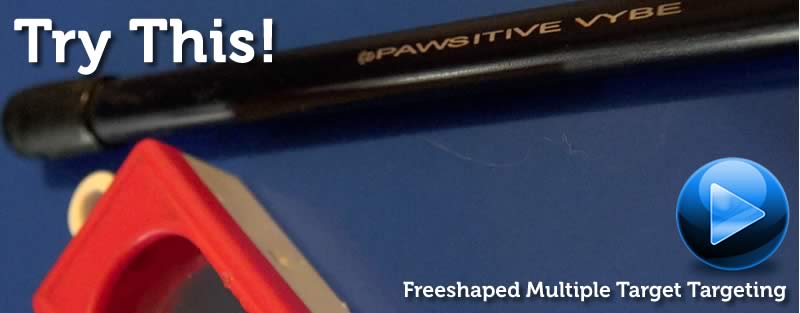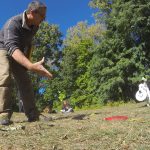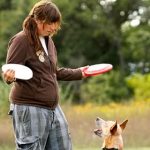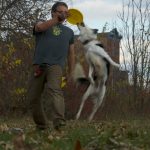
Exercise – Freeshaped Multiple Target Targeting
Note: in the video linked above, LaVerne demonstrates this exercise at 15:14 and 23:16
Freeshaped Multiple Target Targeting is a training exercise that we do with nearly all of our clients who take personal lessons from us.
It is a great learning opportunity for both dog and handler and really does a great job of displaying the power of positive dog training. Done right, this exercise will be a strong foundational building block for dog and handler in terms of communication and team building.
Please give it a look, give it a spin Spins and Twists are tricks where the dog spins 360 degrees in a clockwise or counter clockwise fashion. Spin is clockwise and Twist is counter clockwise so it is important to have a... More and don’t be afraid to ask questions or give us your thoughts below. And by all means, if you video it and post it online I’ll take a look at it and give you some thoughts.
Spins and Twists are tricks where the dog spins 360 degrees in a clockwise or counter clockwise fashion. Spin is clockwise and Twist is counter clockwise so it is important to have a... More and don’t be afraid to ask questions or give us your thoughts below. And by all means, if you video it and post it online I’ll take a look at it and give you some thoughts.
Pre-Requisites
Charged Positive MarkerA Positive Marker is a signal that is used to communicate the exact instant that a behavior is correct and that predicts a positive consequence. A click of the clicker is a Positive... More – Object Targeting
Objective
Handler:
- Increase handler’s understanding of setting proper criteria
- Increase handler’s understanding of dog’s frustration threshold and dog’s ability to work through frustration
- Learn to use variable reinforcement and frustration for stronger expression of behavior
Dog:
- Learn to think during the freeshaping process
- Learn to work through frustration
- Set up conceptual understanding of object discrimination
Equipment
4-5 weighted objects that are not dog toys one of which is able to be tipped over (but not break)
Lots of Yummy Cookies
The Set Up
In a localized area, like the kitchen, place all objects on the floor. Grab a seat and chill out.
Process
Stage 1: 5-10 minutes
Free shape a target on each object. Using nothing but your positive marker and reward placement, get the dog to touch each object.
Stage 2: 5-10 minutes
Once each object has been targeted several times then switch to the target of your choice.
Stage 3: 5 minutes
Switch to the object that may be tipped over. MarkShort for “Positive Marker”, a Mark is a word or signal given at the exact moment a desired behavior is performed. It’s like a clicker. Mark can also mean the act of marking... More the target of the object and give no reinforcement. You should see a greater expression of the behavior. Up the ante and/or Reinforce the greater expression of the behavior until the object has been tipped over.
Discussion
Comments and questions will be addressed below.
Stage 1:
Don’t miss the first one!!! It could happen as soon as you put the objects down.
Here we are working on our freeshaping skills as a handler. There’s bound to be a little confusion as the dog has several options to choose from. If your dog already has a strong object targeting behavior, stick to your guns on your criteria of a touch, or at the very least a serious and purposeful look. Be sure to get past these lesser expressions of the target behavior as soon as possible. Don’t be afraid to place the reinforcement on or near the target, especially on those that are more difficult for your dog.
Keep the cookies and the energy of the training session flowing and you’ll get much better performance.
Stage 2:
Here’s where it gets fun. Your dog is going to get frustrated. Resist the urge to use a No Reward Marker – this exercise is about working through frustration, taking direction and thinking, it has little to do with getting the correct answer.
Start with a hot item, an item the dog is hitting easily. Mark and reinforce the targeting behavior at least 5 times then move on to another target.
When you switch, your dog is going to get frustrated. He’ll keep hitting the target that has paid out. Give The Give is a retrieve to the hand. A cued Give is a foundational skill that is not super useful in the actual performance of disc dog freestyle, and has huge applications for... More no acknowledgment of this – zero reinforcement Note how the frustration manifests itself with a greater expression of the behavior – your dog will hit the object again and probably do it harder. Just wait.
The Give is a retrieve to the hand. A cued Give is a foundational skill that is not super useful in the actual performance of disc dog freestyle, and has huge applications for... More no acknowledgment of this – zero reinforcement Note how the frustration manifests itself with a greater expression of the behavior – your dog will hit the object again and probably do it harder. Just wait.
Be sure to capture the next targeted object – don’t miss it. If your dog is very frustrated, you might need to shape the target by marking and reinforcing interest, acknowledgment or proximity to the new target. You may or may not reinforce on or near the new target depending on how direct a path you want to draw to the new objective or how frustrated your dog is. Resist the urge to draw them a complete map and make this happen for them. Again, this is about learning to think, take direction and to work through frustration.
Once your dog gets a few targets under his belt, it should start to move more smoothly. If he goes back to a previous target, ignore it.
If your dog gets really stressed or lays down and is not engaged in the game, try to wait him out. If you get tired of waiting, mark and reinforce eye contact Unsolicited eye contact or Attention is a great way to hook up with a dog. If you have something the dog wants he should give eye contact in order to get access to... More and place or toss the reinforcement by the new object. Don’t be a pushover! Remember the dog’s objective.
Unsolicited eye contact or Attention is a great way to hook up with a dog. If you have something the dog wants he should give eye contact in order to get access to... More and place or toss the reinforcement by the new object. Don’t be a pushover! Remember the dog’s objective.
If your dog quits and leaves the area, make note of when, how and why he quit and how you can stop it from happening in the future. Take A Take is a cued Bite that replicates the placement and timing of a throw. Usually used with overs, vaults, and flips, the Take is a powerful teaching tool for creating habitual leaping... More a break and start again in a few. Lower your criteria for success on the next object, go back to a hot object or go back to stage 1.
A Take is a cued Bite that replicates the placement and timing of a throw. Usually used with overs, vaults, and flips, the Take is a powerful teaching tool for creating habitual leaping... More a break and start again in a few. Lower your criteria for success on the next object, go back to a hot object or go back to stage 1.
Stage 3:
Variable reinforcement (Yes! no cookie) of behavior is different from variable marking of behavior (no mark no cookie). I’m going against some of the big boys of positive dog training here, but I do believe that marking and not reinforcing the proper behavior is entirely different from not marking a proper behavior.
Variable reinforcement lets the dog know that the behavior is correct and to keep working. The keen and operant dog will either reproduce that behavior or the next behavior in the chain – often at a greater intensity.
Variable marking will not let the dog know that the behavior is correct and the keen and operant dog may or may not reproduce that behavior and will lose track of the fact that the behavior that was not marked is indeed part of the chain.
Make sure that this object is neither a pushover nor a tank. It needs to be selected so that it is not going to tip over at normal target intensity and is not so hard to topple that it’s just not going to happen.
Please share your questions and comments in the comments below.







